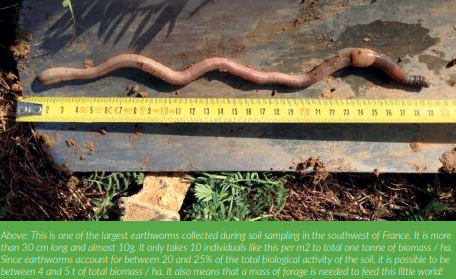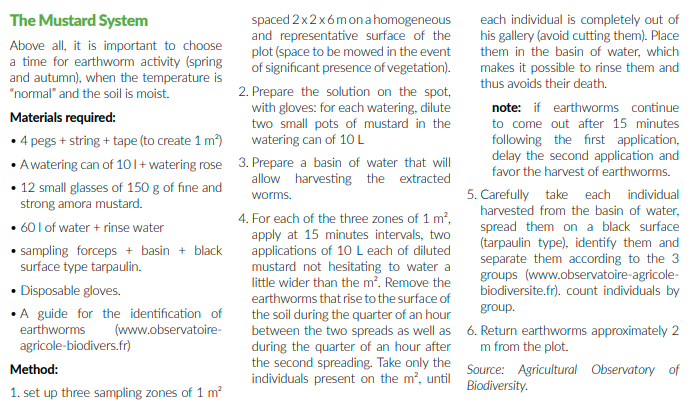The undisputed indicator of a “healthy” soil is the earthworm. There are various methods of sampling (or extraction) in order to estimate a level of communities and analyse the different species present. But what is the best of these methods, both chemical or mechanical in nature? In this article we will discuss the methods you can use on your own farms.

Two extraction methods are commonly used in the field: one is chemical with mustard and the other mechanical, simply using a good spade. Mustard contains an active ingredient, allyl isothiocyanate (abbreviated AITC) which has urticating properties. As soon as they feel the presence of the molecule, earthworms have only one desire: to flee! The protocol, clearly defined by the Agricultural Observatory of Biodiversity (see box insert).

The mechanical extraction consists of sampling at several different locations representative of the land parcel, a block of soil corresponding to the dimensions of the spade used, then “delicately” dissecting said block in order to account for the current earthworm community. It could not be simpler.
How Effective are these methods?
Some time ago, we interviewed a number of zero tillers about these methods. This was not a formal survey, but it has allowed us to confirm the importance of the earthworm and the need to monitor the condition of your soils according to the level of the Earthworm population present. Farmers that have tried these methods in general find them effective but are critical of the mustard method saying is more time-consuming than the spade. A question is also raised, although these two methods appear effective, do they allow us to catalogue all the individuals present? In other words: are the worms, disturbed either by the mustard or by the mechanical disturbance of the spade, not fleeing outside the sampled block?
We asked Guénola Pérès, a recognized expert on earthworms at the Agrocampus Ouest agronomy school in Rennes: “Indeed, the addition of the chemical extractant can cause them to flee; for example to push them down further into the soil, instead of bringing them up. From experience, I can say that by reflex, they flee mostly to the top, where oxygen is most present. Regardless of the method, it will always remain a possible approach and should not be assumed to be an exhaustive count of a community at a given location. We cannot achieve 100% accuracy, but we can get close to it and thus have a picture as representative as possible of a community within the soil parcel.
The sampling technique for the chemical method is important to make it possible to find all the species in a population and to have the best analysis of them. Added to this the need for three or even four repetitions of the process. The sampling surface of the mechanical method is smaller, but does risk losing efficiency compared to the chemical technique. “That’s why we have to repeat the extraction here too. With the spade, one can pick a place poor in earthworms whereas at the side, there were more.
That’s why, I advise, when doing the test with the spade, to repeat at least 5 or 6 times” (G. Pérès) Soil vibration due to penetration of the tool can also cause individuals to flee outside the sampling area. “It all depends, in fact, on the force with which the person puts in his spade and the speed with which it extracts its block,” says Guénola. “It is better to do it as quickly as possible so the strength is rather an advantage. Above all, do not “slice” your block slices because it is necessary to avoid cutting worms as much as possible. On the other hand, you really have to take the whole volume of soil: once the block is removed, if there is soil left in the hole (which often happens), you have to have a clean hole with sharp edges. Also some researchers, when using the spade, will still spread in the hole a solution of mustard, or even formalin which traps recalcitrant anecdotes.
Moist soil, Wet and Active Worm
The method depends on the soil conditions. Sampling should not be done in dry soil but in hot and sunny weather. The soil must be sufficiently warmed up. Otherwise, some of your worms will be inactive, rolled in a ball in cavities and they will not go up, even with an extractant. The chemical method is therefore ineffective when the soil is not humid enough. It is better to sample in the autumn or at the end of winter, when the soil is moist but not waterlogged.

When it’s hot, the time of day is also important. Sampling should not take place in direct sun or hot weather! Even if the mustard effect forces them to the surface, as soon as they feel the sun, the anecdics can plunge again. It is therefore advisable to take the samples at the beginning or end of the day.
Finally, G. Pérès insists: you have to know how to take your time. This too will influence the quality of the result you get. For example, if your sampling area is very full of vegetation, you should take the time to mow, also take the trouble to harvest all the worms present in the entanglements of roots. These too count! At this level, cultivation in the autumn does not make it easy for us … We will end with another question about the mustard method: why is it advisable to use the mustard brand Amora Fine and Strong? Not that the researchers are sponsored by Amora but simply because this mustard is everywhere, and it is better to use the same product to have references and make comparisons. When you use another mustard, you can get different results. Finally, the pots are then practical to store the earthworms punctually during the sampling before releasing them. Just like fishermen we identify them, we count them, we weigh them and possibly we take a picture with before releasing them! Editor’s note – although “Aroma fine and strong” maybe common in France we suggest that in the UK Colman’s mustard maybe a more consistently easy to find product!
Mustard is not the only extractant that will bring out earthworms from their galleries. there is formalin, much more effective, still used in scientific experiments but not recommended, because of its toxicity for users. Mustard, less toxic, is much easier to use; it is not expensive, and we find it everywhere. G. Peres and his students went looking for other extractants. “I had hopes for vinegar,” says the scientist. I still have some but for the moment, it’s not conclusive. In high concentrations, vinegar kills earthworms. Among all the tested products, wasabi has been quite interesting, even more effective than mustard. Wasabi, as well as being a condiment used in Japanese cuisine, it is originally a plant of the Brassicaceae family. The condiment is obtained from the stem Eutrema japonicum which is obtained as a green paste. but wasabi is not found at every street corner and it is an expensive product to extract earthworms when compared to mustard!
Mustard is not used pure. It is diluted at the rate of 300 g per 10 L of water. A good dilution is essential to the success of the method. if your mustard solution is not properly mixed, more concentrated solution pockets are formed and the method is biased. So, mix and mix again before spreading! The specialists even recommend shaking the mustard beforehand in a container with a little water like a cocktail barman might!
